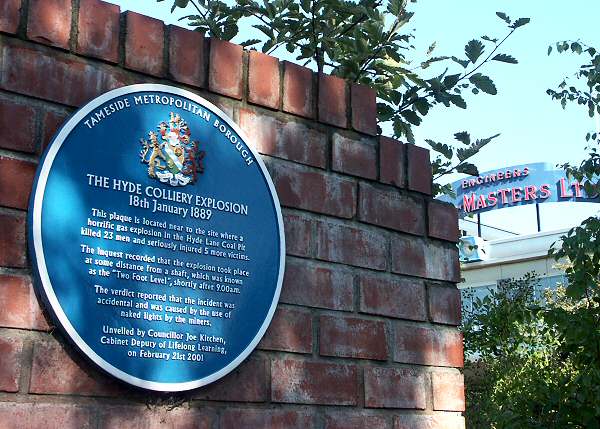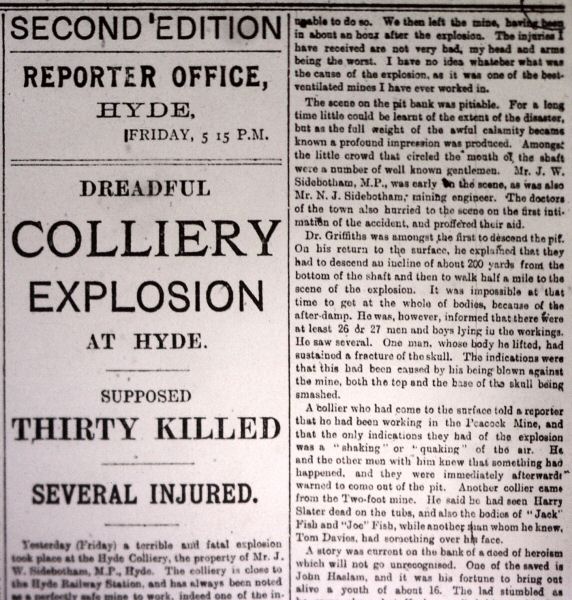

THE HYDE COLLIERY EXPLOSION
18th January 1889
This plaque is located near to the site where a
horrific gas explosion in the Hyde Lane Coal Pit
killed 23 men and seriously injured 5 more victims
The inquest recorded that the explosion took place
at some distance from a shaft, which was known
as the "Two Foot Level", shortly after 9.00a.m.
The verdict reported that the incident was
accidental and was caused by the use of
naked lights by the miners.
Unveiled by Councillor Joe Kitchen,
Cabinet Deputy of Lifelong Learning,
on February 21st 2001.

The main shaft of Hyde Road Pit was 880 feet deep. From its bottom, coal seams slope downwards at 28 degrees. The workface was "about a mile from the mouth of the pit" and well over 1,100 feet beneath the surface.
The 200 men of the morning shift went down as usual at 5:30 am. More men than normal because some had been transferred from the recently flooded Broomstair Pit. The explosion occurred just after 9am, in the Two-Foot Seam, where 43 men were working: 26 colliers, 10 waggoners, 4 jiggers and takers off, 1 datler, and 2 pony drivers.
Rescuers immediately entered the pit, braving foul air and roof falls. The living were soon brought out. The injured were treated at the pit head by local doctors. The Hyde Reporter said they: "were burned in various parts, principally about the head and shoulders, and as soon as possible they were conveyed to their homes." The last of the bodies was recovered by 8:45 that evening.
The explosion occurred on Friday morning. The local weekly newspapers were already well on the way to press. The North Cheshire Herald was edited and printed "on our steam printing press" in Hamnett Street just a quarter mile away. Its first Saturday edition did not mention the explosion. But the presses were soon producing extra editions. The first edition of the Hyde Reporter had a brief paragraph. Full details were published in a second edition headlined Saturday, but actually produced at 5:45 pm on Friday.
The inquest opened at the nearby Navigation Hotel. It was told that most of the deaths were caused by suffocation, not by burning or blast. The blast had caused some destruction in the pit and had extinguished the lights.
James DAVIES was one of those who gave evidence. He was working alongside those who died. He heard a thump and was blown off his feet, but not badly injured. The normal exit route had been blocked by a fallen roof. He described a harrowing fight for survival trying with others in the blackness to find a way to the main shaft. through a labyrinth of passages linking other seams and old workings. Time after time he was driven back by bad air. Eventually he made it to safety.
William GEE, described how he was knocked down and thrown a few yards by the explosion. All the lights were blown out, and there was complete blackness. He followed a current of air through the workings to find his way out.
Others who gave evidence included: Edward JACKSON, of Woodend Lane, Hyde, underlooker at the colliery and Joseph GOODWIN, the pit manager. Early reports named the owners of the pit as J W SIDEBOTHAM MP, and J N SIDEBOTHAM. At the inquest this was anonymised to the Hyde and Haughton Colliery Company.
Naked candles were commonly used in the pit. Management and workers had agreed that it was safe because there was hardly any sign of gas in the pit, and it was very well ventilated.
The inquest decided that there had been a release of gas during a roof fall, and the explosion had been triggered by a naked flame.
Seven horses worked in the pit. Three were in the Two Foot seam at the time of the explosion. All survived.
The pit resumed production at 5:30am on Thursday 24th January.
The 23 who died are:
Some of the survivers were:

Image courtesy of Tameside Local Studies and Archives Unit